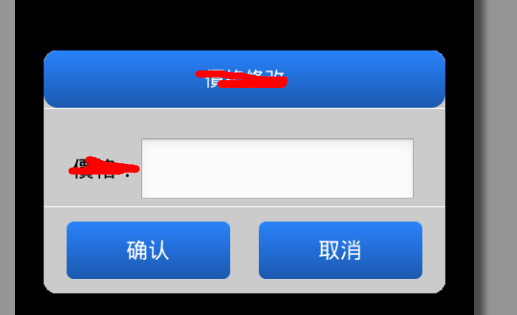您好,登錄后才能下訂單哦!
您好,登錄后才能下訂單哦!
這篇文章將為大家詳細講解有關Android編程怎么實現在自定義對話框中獲取EditText數據,小編覺得挺實用的,因此分享給大家做個參考,希望大家閱讀完這篇文章后可以有所收獲。
在項目中忽然遇到這樣的問題,需要自定義對話框,對話框需要有一個輸入框,以便修改所選中的價格,然后點擊確定之后,修改所顯示的價格。遇到的最大的問題就是如何能夠獲取到自定義對話框當中edittext輸入的數值,百度了很久,看到的答案都是如下:
//得到自定義對話框 final View DialogView = a .inflate ( R.layout.loand, null);
這是關鍵的代碼
//創建對話框
AlertDialog dlg = new AlertDialog.Builder(loand.this)
.setTitle("登錄框")
.setView(DialogView)//設置自定義對話框的樣式
.setPositiveButton("登陸", //設置"確定"按鈕
new DialogInterface.OnClickListener() //設置事件監聽
{
public void onClick(DialogInterface dialog, int whichButton)
{
editText1 =(EditText) DialogView.findViewById(R.id.editText1);
editText2 =(EditText) DialogView.findViewById(R.id.editText2);
String id = editText1.getText().toString();
String password = editText2.getText().toString();
//輸入完成后,點擊“確定”開始登陸
c_log judge = new c_log();
boolean b_judge = judge.aa(id,password);
if(b_judge){
bar();
}else{
//加東西
DisplayToast("NO");
}
}
})上述方法對于使用系統自帶的alertdialog來說,的確是沒有問題,能夠取到你輸入的edittext的值,但對于自定義的alertdialog來說,就會始終拿到的是空的,我的解決方案是在自定義alertdialog里面取到edittext并且實例化,避免在activity里面進行初始化,步驟如下:
1.主要的activity主類代碼:
package client.verbank.mtp.allone.frame.systemsettings;
import android.app.AlertDialog;
import android.content.DialogInterface;
import android.content.Intent;
import android.os.Bundle;
import android.os.Handler;
import android.view.LayoutInflater;
import android.view.View;
import android.view.View.OnClickListener;
import android.view.ViewGroup;
import android.widget.CompoundButton;
import android.widget.CompoundButton.OnCheckedChangeListener;
import android.widget.TextView;
import android.widget.ToggleButton;
import client.verbank.mtp.allone.R;
import client.verbank.mtp.allone.component.CustomDialogPriceModify;
import client.verbank.mtp.allone.consts.IBundleCommData;
import client.verbank.mtp.allone.consts.ISystemCommData;
import client.verbank.mtp.allone.frame.ControlFragment;
import client.verbank.mtp.allone.frame.MainActivity;
import client.verbank.mtp.allone.frame.systemsettings.nextpage.ChangePasswordActivity;
import client.verbank.mtp.allone.frame.systemsettings.nextpage.ChangePhonePinActivity;
import client.verbank.mtp.allone.frame.systemsettings.nextpage.ChooseRssActivity;
import client.verbank.mtp.allone.frame.systemsettings.nextpage.SelectInstrumentActivity;
import client.verbank.mtp.allone.util.SharepreferencesUtilSystemSettings;
/**
* 系統設置界面
*
* @Project: FEIB_AndroidStation
* @Title: SystemSettingsFragment.java
* @Package client.verbank.mtp.allone.frame.systemsettings
* @Description: TODO
* @author qiulinhe qiu.linhe@allone.cn
* @date 2015年9月29日 上午11:48:53
* @Copyright: 2015 www.allone.cn Inc. All rights reserved.
* @version V3.0.0
*/
public class SystemSettingsFragment extends ControlFragment implements
ISystemCommData {
// 四組需要打鉤的textview初始化
private TextView currencypairs;
private TextView openpositionprice;
private TextView floatingprofit;
private TextView dealtime;
private TextView ordercurrencypairs;
private TextView pricehighend;
private TextView priceendhigh;
private TextView summarycurrencypairs;
private TextView summaryfloatingprofit;
private TextView riseandfall;
private TextView applies;
// 三個自定義輸入金額
private TextView inputamount2;
private TextView inputamount5;
private TextView inputamount10;
// 跳轉到下一個頁面的4個textview,貨幣對選擇、密碼修改、憑證密碼修改、RSS源選擇
private TextView Currencyofchoice;
private TextView changepassword;
private TextView changecertificatepassword;
private TextView rsssource;
ToggleButton mosthightoggle;
ToggleButton mostlowtoggle;
ToggleButton riseandfallmenutoggle;
ToggleButton pricetimetoggle;
View layout;
// EditText price;
AlertDialog dlg;
int flagprice = 0;
private Handler handler = new Handler();
public SystemSettingsFragment(MainActivity activity) {
super(activity);
}
@Override
public View onCreateView(LayoutInflater inflater, ViewGroup container,
Bundle savedInstanceState) {
View vi = inflater.inflate(R.layout.system_settings, container, false);
// 價格修改彈出對話框
layout = inflater.inflate(
R.layout.activity_systemsettings_pricecustom_dialog,
(ViewGroup) vi.findViewById(R.id.dialog));
//。。。。。。。。。。省略了部分代碼,因為是公司項目的。。。。。。。。。。。。。。
// 三個自定義金額的監聽事件
private void selfThreeMoneyLister(View vi) {
inputamount2.setOnClickListener(new OnClickListener() {
@Override
public void onClick(View v) {
modifyPriceDialog();
flagprice = 1;
}
});
inputamount5.setOnClickListener(new OnClickListener() {
@Override
public void onClick(View v) {
modifyPriceDialog();
flagprice = 2;
}
});
inputamount10.setOnClickListener(new OnClickListener() {
@Override
public void onClick(View v) {
modifyPriceDialog();
flagprice = 3;
}
});
}
// 點擊價格,彈出編輯框,對價格進行修改
private void modifyPriceDialog() {
LayoutInflater factory = LayoutInflater.from(getActivity());
final View DialogView = factory.inflate(
R.layout.activity_systemsettings_pricecustom_dialog, null);
final CustomDialogPriceModify.Builder builder = new CustomDialogPriceModify.Builder(
getActivity());
builder.setTitle("價格修改");
builder.setPositiveButton(R.string.confirm,
new DialogInterface.OnClickListener() {
@Override
public void onClick(DialogInterface dialog, int which) {
// 獲取edittext的值
String priceStr = builder.getPrice();//關鍵代碼,getPrice放在自定義的alertdialog類里面,進行初始化
if (flagprice == 1) {
inputamount2.setText(priceStr);
SharepreferencesUtilSystemSettings.putValue(
getActivity(), System_key_SelfAmout2,
priceStr);
} else if (flagprice == 2) {
inputamount5.setText(priceStr);
SharepreferencesUtilSystemSettings.putValue(
getActivity(), System_key_SelfAmout5,
priceStr);
} else {
inputamount10.setText(priceStr);
SharepreferencesUtilSystemSettings.putValue(
getActivity(), System_key_SelfAmout10,
priceStr);
}
// price.setText("");
/**
* 取得view的父組件,然后移除view
*/
dialog.dismiss();
}
});
builder.setNegativeButton(R.string.cancel,
new android.content.DialogInterface.OnClickListener() {
@Override
public void onClick(DialogInterface dialog, int which) {
// TODO Auto-generated method stub
// ((ViewGroup) layout.getParent()).removeView(layout);
dialog.dismiss();
}
});
builder.create().show();
}
}2.自定義alertdialog類,CustomDialogPriceModify.java,如下:
package client.verbank.mtp.allone.component;
import android.app.Dialog;
import android.content.Context;
import android.content.DialogInterface;
import android.view.LayoutInflater;
import android.view.View;
import android.view.ViewGroup.LayoutParams;
import android.widget.Button;
import android.widget.EditText;
import android.widget.TextView;
import client.verbank.mtp.allone.R;
/**
* 系統設定中修改價格的彈出對話窗口
*
* @author wangyubo
*
*/
public class CustomDialogPriceModify extends Dialog {
public CustomDialogPriceModify(Context context) {
super(context);
}
public CustomDialogPriceModify(Context context, int theme) {
super(context, theme);
}
public static class Builder {
private Context context;
private String title;
private float textSize;
private String message;
private String positiveButtonText;
private String negativeButtonText;
private View contentView;
private EditText priceText;
private DialogInterface.OnClickListener positiveButtonClickListener;
private DialogInterface.OnClickListener negativeButtonClickListener;
public Builder(Context context) {
this.context = context;
}
public Builder setMessage(String message) {
this.message = message;
return this;
}
public Builder setMessage(String message, float textSize) {
this.message = message;
this.textSize = textSize;
return this;
}
/**
* Set the Dialog message from resource
*
* @param title
* @return
*/
public Builder setMessage(int message) {
this.message = (String) context.getText(message);
return this;
}
/**
* Set the Dialog title from resource
*
* @param title
* @return
*/
public Builder setTitle(int title) {
this.title = (String) context.getText(title);
return this;
}
/**
* Set the Dialog title from String
*
* @param title
* @return
*/
public Builder setTitle(String title) {
this.title = title;
return this;
}
public Builder setContentView(View v) {
this.contentView = v;
return this;
}
/**
* Set the positive button resource and it's listener
*
* @param positiveButtonText
* @return
*/
public Builder setPositiveButton(int positiveButtonText,
DialogInterface.OnClickListener listener) {
this.positiveButtonText = (String) context
.getText(positiveButtonText);
this.positiveButtonClickListener = listener;
return this;
}
//關鍵代碼
public String getPrice() {
return priceText.getText().toString();
}
public Builder setPositiveButton(String positiveButtonText,
DialogInterface.OnClickListener listener) {
this.positiveButtonText = positiveButtonText;
this.positiveButtonClickListener = listener;
return this;
}
public Builder setNegativeButton(int negativeButtonText,
DialogInterface.OnClickListener listener) {
this.negativeButtonText = (String) context
.getText(negativeButtonText);
this.negativeButtonClickListener = listener;
return this;
}
public Builder setNegativeButton(String negativeButtonText,
DialogInterface.OnClickListener listener) {
this.negativeButtonText = negativeButtonText;
this.negativeButtonClickListener = listener;
return this;
}
public CustomDialogPriceModify create() {
LayoutInflater inflater = (LayoutInflater) context
.getSystemService(Context.LAYOUT_INFLATER_SERVICE);
// instantiate the dialog with the custom Theme
final CustomDialogPriceModify dialog = new CustomDialogPriceModify(
context, R.style.Dialog);
dialog.setCanceledOnTouchOutside(false);
dialog.setCancelable(false);
View layout = inflater.inflate(
R.layout.activity_systemsettings_pricecustom_dialog, null);
dialog.addContentView(layout, new LayoutParams(
LayoutParams.FILL_PARENT, LayoutParams.WRAP_CONTENT));
// set the dialog title
((TextView) layout.findViewById(R.id.title)).setText(title);
priceText = (EditText) layout.findViewById(R.id.price);
//對edittext進行初始化,關鍵代碼
if (positiveButtonText != null) {
((Button) layout.findViewById(R.id.positiveButton))
.setText(positiveButtonText);
if (positiveButtonClickListener != null) {
((Button) layout.findViewById(R.id.positiveButton))
.setOnClickListener(new View.OnClickListener() {
@Override
public void onClick(View v) {
positiveButtonClickListener.onClick(dialog,
DialogInterface.BUTTON_POSITIVE);
}
});
}
} else {
// if no confirm button just set the visibility to GONE
layout.findViewById(R.id.positiveButton).setVisibility(
View.GONE);
}
// set the cancel button
if (negativeButtonText != null) {
((Button) layout.findViewById(R.id.negativeButton))
.setText(negativeButtonText);
if (negativeButtonClickListener != null) {
((Button) layout.findViewById(R.id.negativeButton))
.setOnClickListener(new View.OnClickListener() {
@Override
public void onClick(View v) {
negativeButtonClickListener.onClick(dialog,
DialogInterface.BUTTON_NEGATIVE);
}
});
}
} else {
// if no confirm button just set the visibility to GONE
layout.findViewById(R.id.negativeButton).setVisibility(
View.GONE);
}
// set the content message
if (message != null) {
TextView msgView = (TextView) layout.findViewById(R.id.message);
msgView.setText(message);
if (textSize != 0) {
msgView.setTextSize(textSize);
}
} else if (contentView != null) {
}
dialog.setContentView(layout);
return dialog;
}
}
}3.剩下的就是布局代碼,包括一些圓角的,如果需要的可以參考我之前的博文,就不貼代碼了。完成效果如下:

Android是一種基于Linux內核的自由及開放源代碼的操作系統,主要使用于移動設備,如智能手機和平板電腦,由美國Google公司和開放手機聯盟領導及開發。
關于“Android編程怎么實現在自定義對話框中獲取EditText數據”這篇文章就分享到這里了,希望以上內容可以對大家有一定的幫助,使各位可以學到更多知識,如果覺得文章不錯,請把它分享出去讓更多的人看到。
免責聲明:本站發布的內容(圖片、視頻和文字)以原創、轉載和分享為主,文章觀點不代表本網站立場,如果涉及侵權請聯系站長郵箱:is@yisu.com進行舉報,并提供相關證據,一經查實,將立刻刪除涉嫌侵權內容。